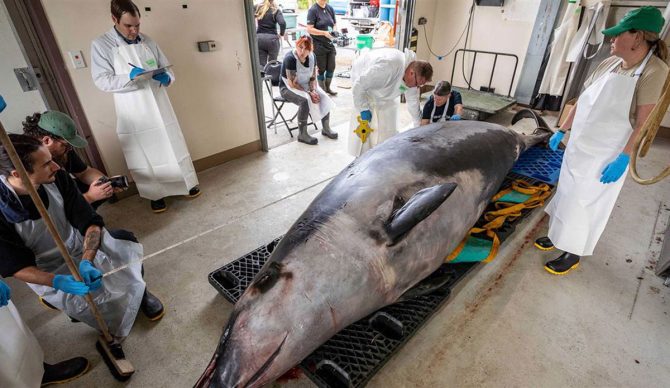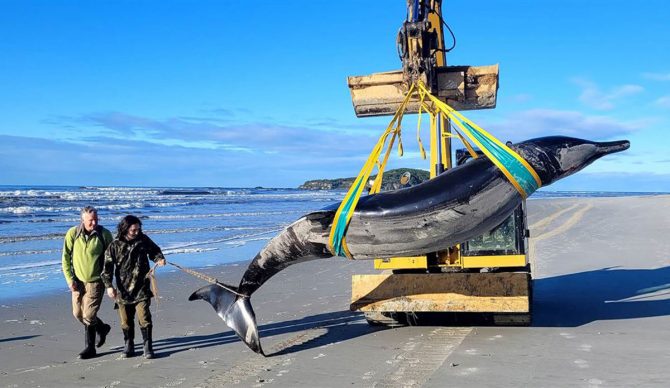
Vestigial teeth and nine stomach chambers were just a few of the surprises waiting inside the spade-toothed whale. Photo: NZ Dept. of Conservation
Scientists recently cut into the body of a spade-toothed whale, one of the world’s rarest animals. It was the first time anyone had ever done it, and researchers were, as you’d expect, surprised.
When the spade-toothed whale, which up until July 4, 2024, had only been documented five times, washed up on a beach in Otago, New Zealand, that number was brought to six. It’s not all that uncommon for whales to beach themselves in New Zealand — around 85 of them do it each year. So when the Department of Conservation (DOC) and the Museum of New Zealand Te Papa Tongarewa answered a call about a dead beached whale, they weren’t all that surprised. When they arrived on site, however, the responders’ jaws hit the sand.
“Spade-toothed whales are one of the most poorly known large mammalian species of modern times,” said DOC Coastal Otago Operations Manager Gabe Davies in a statement. “Since the 1800s, only six samples have ever been documented worldwide, and all but one of these was from New Zealand. From a scientific and conservation point of view, this is huge.”
The dissection of the world’s rarest whale helped both Indigenous people and conservation scientists in New Zealand learn more about an incredibly mysterious creature. No one has ever seen one alive, and most of the beached bodies have been in some state of decay. This recent one was in very good condition, which led to various strange discoveries, including the fact that the spade-toothed whale has nine stomach chambers.

The whale that washed up in July was only the sixth one ever to be found. Photo: NZ Dept. of Conservation
“Not only was this tohorā (whale) the first of its kind to be dissected by science, but it was also the first time our hapū (subtribe) worked with scientists to pull together Indigenous and western knowledge systems so we can all gain a better understanding of the whale and its behaviors,” said Rūnanga member Rachel Wesley in a recent statement on the dissection. “This process was led by our rakatahi (young people) and guided by our esteemed guests from Ngāti Wai – Hori Parata and his son Te Kaurinui – who are tōhuka (experts) in working with these taoka (treasures). By working with and learning from leaders in te ao Māori, as well as leaders in western science, our rakatahi can revive ancient matauraka (knowledge) and develop an in-depth knowledge system to pass onto the next generations.”
Also of note are the facts that spade-toothed whales have vestigial teeth in their upper jaw. Vestigial traits are generally thought to be evolutionary hangers-on that have shrunk after their initial purpose was taken over by something else.
“These little teeth embedded in the gum tells us something about their evolutionary history,” said DOC Marine Science Advisor and beaked whale expert Anton van Helden. “It’s remarkable to see this and it’s just another thing that we had no idea about.”
The nine stomach chambers was of particular interest to the researchers, because it gives them clues into what spade-toothed whales eat and possibly how they communicate with each other.
“In some of those stomachs we found squid beaks and some lenses from the eyes of squid, a few parasitic worms, and maybe some other parts of organisms that we are not quite sure of,” said DOC Marine Science Advisor and beaked whale expert Anton van Helden. “We have a parasitologist who will study them to find out what they are. We also found interesting structures associated with both feeding and sound production. Weights and measurements and descriptions were made of various muscles and organs, to help us describe this species and make comparisons with related species. These all add to the body of knowledge we are building.”
While the dissection was more about finding out information about the whale than it was about finding out what killed it, the researchers did find bruising on the head and neck and a broken jaw, leading them to believe it was likely some form of traumatic head injury.
“We don’t know but we suspect there must have been some sort of trauma, but what caused that could be anyone’s guess,” van Helden said. “It’s a week I’ll never forget in my life, it’s certainly a highlight and it’s the start of the storytelling around this beautiful animal.”

